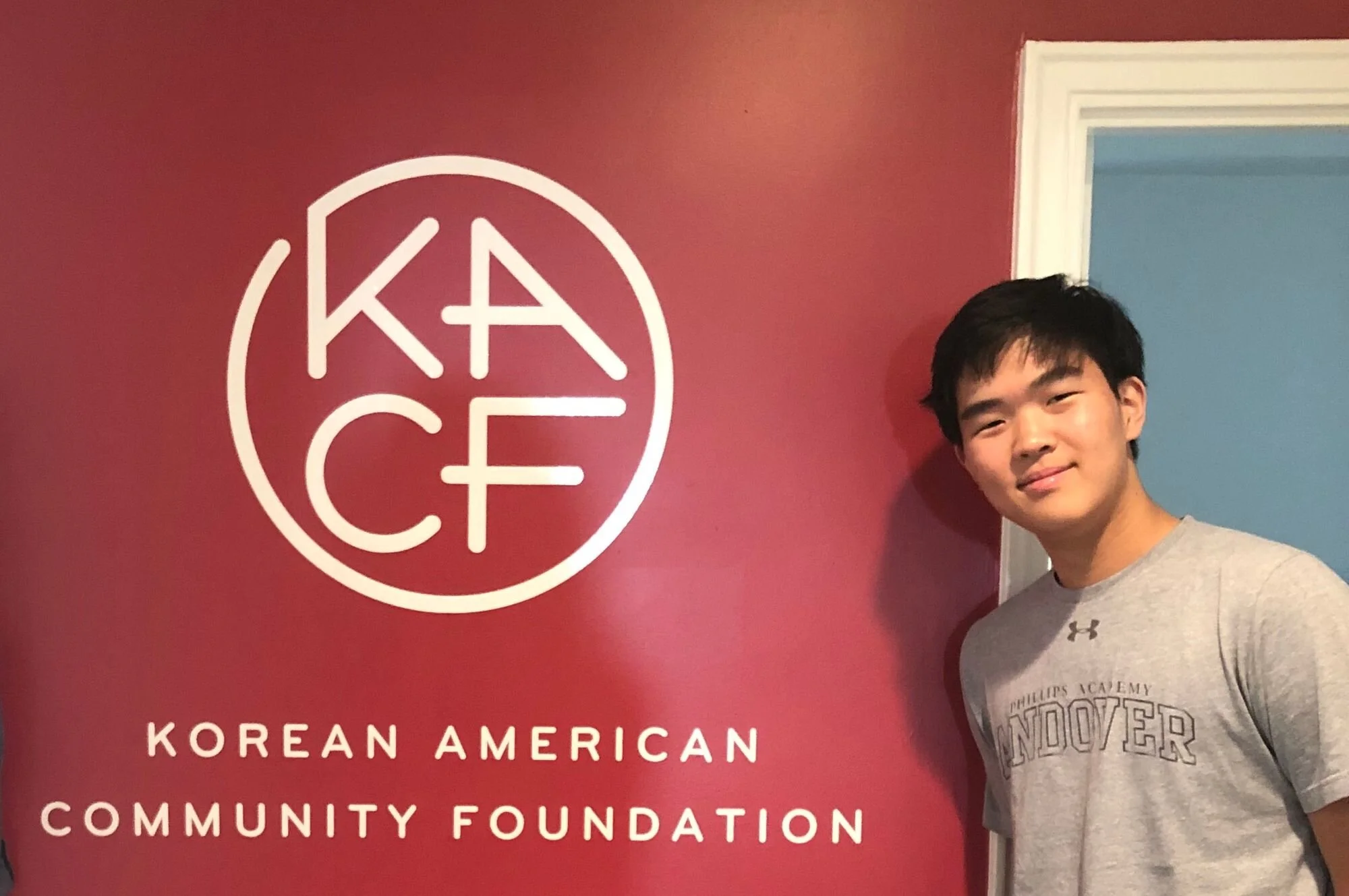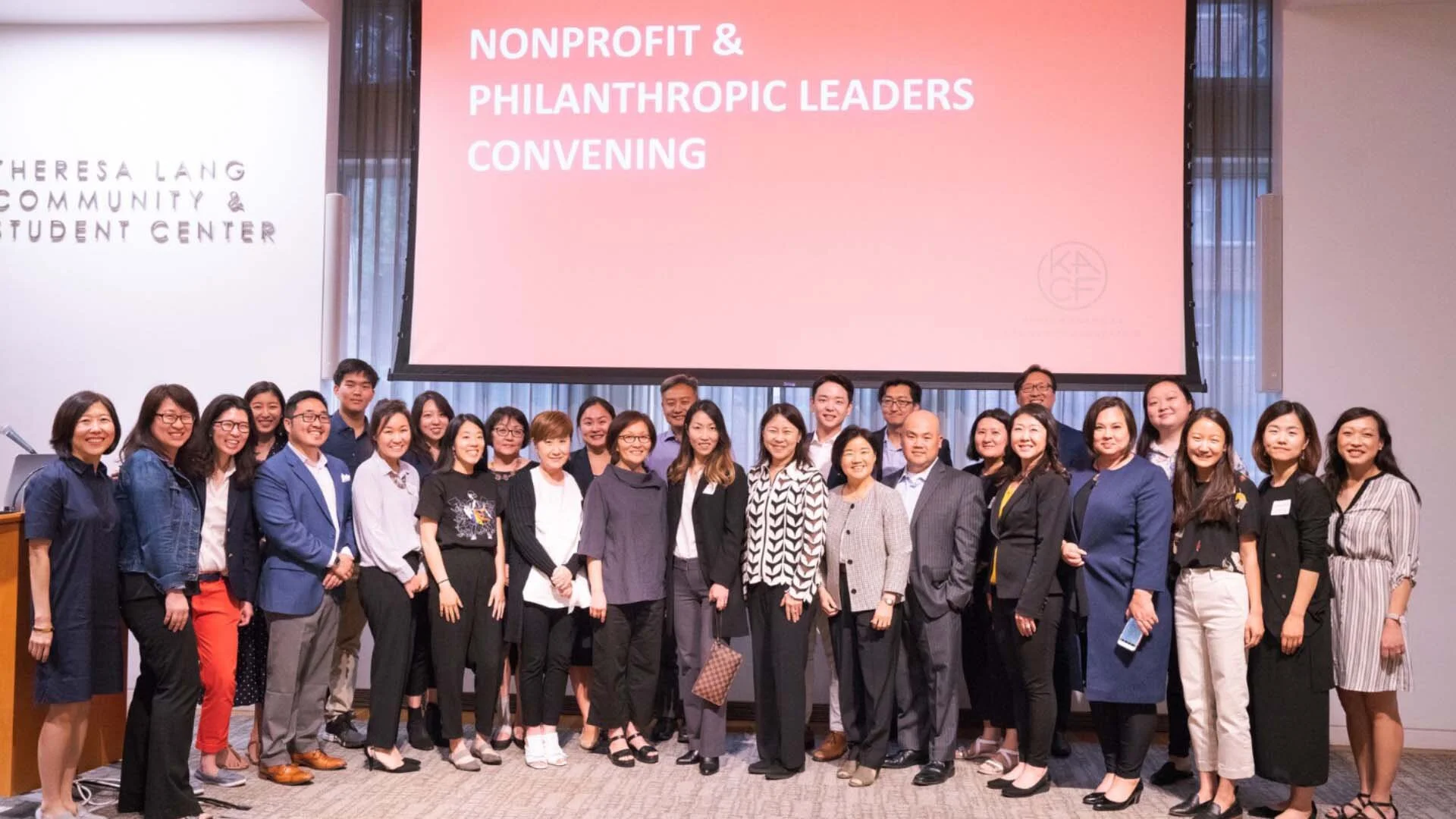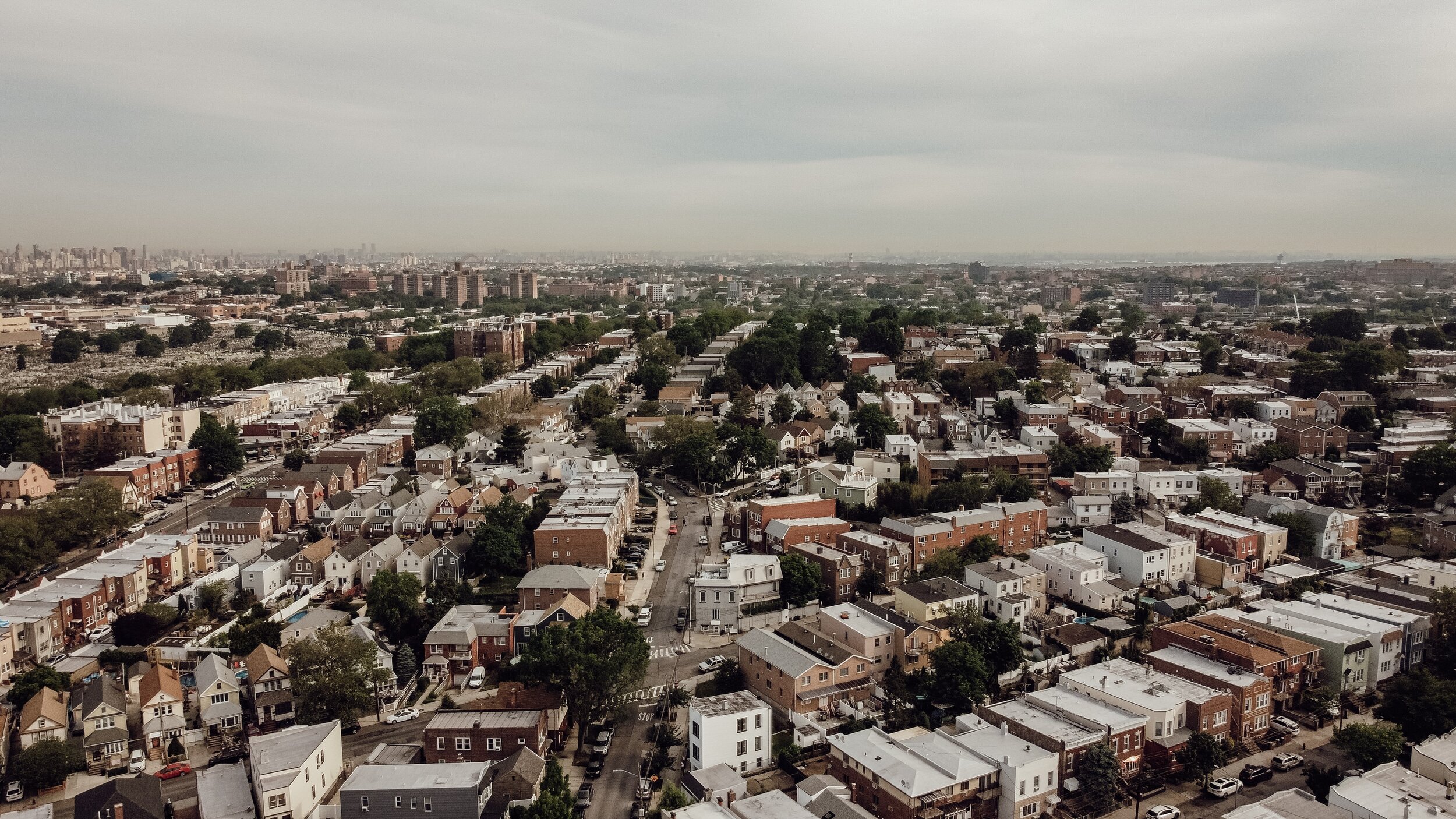
In 2019 and 2020,
more than ever,
the Korean American Community Foundation recalled our 초심—
the spark—that started it all.
Foreword
As a community foundation, we continued to invest in the Korean American community and strengthened our philanthropy, emboldened by the new challenges of a historic pandemic that devastated livelihoods and dreams built over decades.
KACF’s purpose and role in our community became even more clear in a time of emergency. In 2020, we witnessed the specific, disproportionate losses from the COVID-19 pandemic in the Asian American community, and we knew that our 18 years of building and investing had prepared us for this moment. Together, with our nonprofit partners and donors, we extended our hands to small business owners, vulnerable and under-resourced families, and individuals who needed a little lift.
Mrs. Kim, owner of Flushing Garden Florist, has been a client of KACF grantee partner, Renaissance EDC, which supports immigrant small businesses in New York. She had to close her shop temporarily as part of the shutdowns in the early months of the COVID-19 pandemic in 2020.
If we helped a flower shop in Flushing to sprout and stand up on its own before the pandemic, in 2020, we helped to protect it so it could weather the pandemic shutdowns and find a way to bloom in new ways. We adapted, we learned to do things differently, and we found strength and resilience.
Here, we share how the generosity and hard work of the KACF community extended lifelines and a chance to thrive for so many. We also include perspectives from those who continued to build the capacity of nonprofit programs to translate resources into bigger impact, and those who continued to deepen our culture of giving.
We are grateful and emboldened to continue moving forward, together.
Kyung Yoon
President & Co-Founder
Mrs. Kim’s Story
KACF shared Mrs. Kim's story at our virtual Annual Gala 2020. Since then, she told us that the help has gone beyond monetary support. Through continued engagement with Renaissance EDC, Mrs. Kim saw an opportunity to grow her online business, and she is building a new way forward for her flower shop.
GRANTMAKING
KACF invests in programs and initiatives that strengthen the economic security of low-income Korean Americans in the New York metropolitan area. This includes immigrant small business owners, women and children affected by domestic violence, seniors, people with disabilities, and public housing tenants.
Each year, our community's philanthropy lifts thousands of people onto pathways paved by KACF-funded programs, leading them to opportunities to thrive. In 2019-2020, our grantmaking reached more than 7,000 people through direct services and thousands more through educational outreach programs. This is how we invested in our community in 2019 and 2020, with a record-breaking $1 million in grants in 2020 alone:
2019
$835,000
-
To assist with employment
To assist small businesses
To provide access to housing
To provide access to healthcare
To facilitate access to public benefits
-
To provide grantee partners with management consulting
To support KACF Fellowship & share nonprofit knowledge
-
To support research on community needs
To provide data for advocacy & public policy
2019
$1,000,650
-
To assist with employment
To assist small businesses
To provide access to housing
To provide access to healthcare
To facilitate access to public benefits
-
To provide grantee partners with management consulting
To support KACF Fellowship & share nonprofit knowledge
-
Toward KACF membership in Philanthropy New York
-
To provide emergency food & shelter assistance
To provide emergency cash assistance
To support increased counseling & health needs
To assist access to unemployment & small business relief
-

More than 3,000 low-income individuals and seniors were able to navigate applications for government benefits.
-

200 Korean small business owners accessed technical assistance to meet the pandemic's economic challenges.
-

Approximately 2,000 people accessed guidance in applying for unemployment insurance during the pandemic.
-

500 monthly food baskets went to low-income and elderly Korean Americans in New York and New Jersey at the height of the pandemic.
-
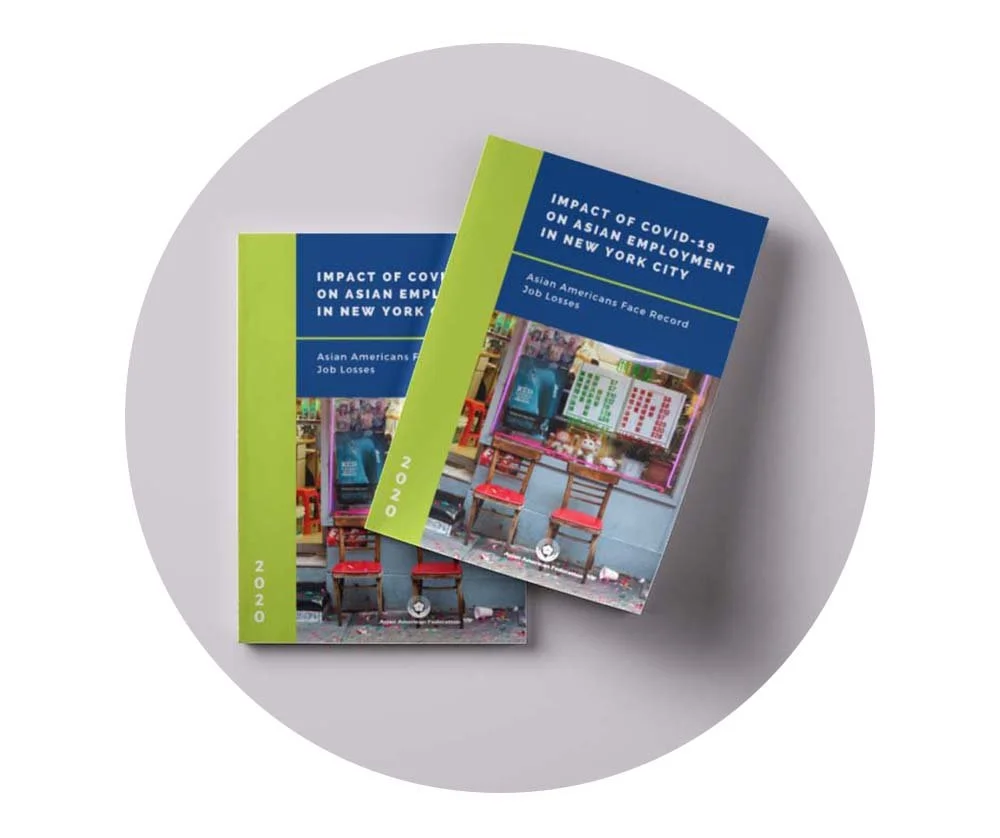
Critical research and data were published in the report, "The Impact of COVID-19 on Asian American Employment in NYC" by the Asian American Federation.
-
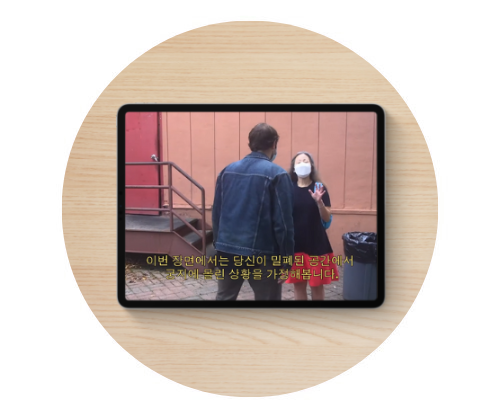
Safety videos were produced to counter anti-Asian violence in the pandemic's wake.
How does KACF's grantmaking change a life?
How does KACF's grantmaking change a life?
At the Korean American Family Service Center (KAFSC), a KACF grantee partner that serves survivors of domestic violence, a client had accessed safe shelter and successfully graduated from an 18-month transitional housing program and an economic empowerment program before the pandemic.
Ms. M secured long-term housing and got a job as a nail technician, and she could look forward to a life of independence, as a single mother of a nine-year-old.
But soon after, in early 2020, the COVID-19 pandemic tested her hard-won progress. As schools and businesses shut down, Ms. M and others lost their livelihoods or had to reduce their work hours. She and her child received cash and food assistance through KAFSC during the pandemic's peak, which helped them through financial uncertainty until she regained her working hours in the summer.
Today, Ms. M and her child are back on track. Her child participates in KAFSC's after-school program and is thriving.
Participatory Grantmaking
Participatory Grantmaking
KACF invites donors to participate in our grantmaking every year through the Community Grants Committee (CGC). Committee members come from diverse personal and professional backgrounds. Under KACF's guidance, the CGC visited seven viable grant applicants in 2019 and nine in 2020, making funding recommendations to KACF following in-depth discussions.
“It was a humbling experience to learn more about KAFSC's work through CGC site visits. Data and written outcomes could not speak to the full story of the KAFSC staff's tireless efforts on the ground. The clients KAFSC serves are not just dots on the map—they are the present and future of the New York community that they wholeheartedly support and cheer for many, many years.”
Emily Bang, 2020 Community Grants Committee
Capacity Building
KACF grants go beyond monetary support. Our Capacity Building Program helps grantee partners to serve our community more effectively and sustainably, through workshops and training, as well as one-on-one consulting.
In 2019-2020, KACF provided capacity building workshops, training and consulting to 25 grantee partners to strengthen nonprofit programs in the Korean American community in New York.
In 2020, KACF's Capacity Building Fellow, Monica Lee, worked with our grantee partner Community Inclusion & Development Alliance (CIDA) to strengthen their capacity to meet their clients' needs.
Monica helped CIDA's team to envision and build their first-ever virtual events to engage families throughout the pandemic, as well as helping to build a strategy for engaging them in the long term. Following the consulting engagement with Monica, CIDA is implementing the roadmap they co-created through brainstorming sessions and focus groups to strengthen their membership alliance. The Korean American community in New York continues to lean on CIDA as they fulfill their mission to increase inclusion opportunities for individuals with disabilities
Advancing a Culture of Giving
Owen Bae, a high school senior at Phillips Academy Andover, was an intern with KACF in 2019 and in 2020.
As a Korean American raised in Hong Kong, he says he did not know much about the Asian American identity, its history or the struggles, until he moved back to the United States in 2015. He spoke with us about community service, his family's reasons for giving back, and how his generation can help the Asian American community.
Tell us how you started your journey with KACF.
I learned about KACF first through my parents. They have been donors, and my uncle and my grandmother have been involved with some of KACF's grantee partners that serve the Korean American community. I took an interest because I was born in the States, but I didn't know much about the Asian American identity, or any of the struggles they faced, and I was really curious to learn more.
For example, I didn't know anything about the model minority myth. I didn't know that Asians in New York had a high poverty rate. I didn't know that there were so many cases of domestic violence, or that we had such a large elderly population that didn't have family members take care of them... I'd say those were probably the biggest culture shocks coming to the United States [from Hong Kong].
What were some things that stood out from your involvement with KACF?
I'd say the biggest thing was when [I helped produce] a virtual panel event last summer, in the middle of the COVID-19 pandemic, called "Our Time Is Now". Another student, Chloe Pae, and I had both reached out, asking, "Is there anything we can do to help?" and we landed on this virtual event to convene a younger audience.
The needs of the Asian American community were changing [in the COVID-19 context]. In New York, Chinatown had been somewhat deserted because people were scared that somehow there would be higher [COVID infection rates] there.
We came together around the rise of anti-Asian racism because of the pandemic. We started this project to get other high school and college students involved,
"I think — and I hope — that as people learn more, they'd only become more involved."
〰️
"I think — and I hope — that as people learn more, they'd only become more involved." 〰️
and, at the very least, to spread awareness about the issues we were learning. The event was centered around getting the voices of the next generation of leaders, and there were so many people who wanted to get involved and help. That made me feel really, really good, and hopeful, about the future.
I also helped with the planning of [a nonprofit convening] in 2019. That was super cool, because KACF could gather so many and such a range of Asian leaders from across the country ... to create a broader network of support, [where] people could share personal and professional experiences surrounding the needs of Asian Americans. It was awe-inspiring for me, to say the least.
Will these experiences inform what you want to do next, in any way?
One element is that I do want to finally take Korean [language classes] when I go to college, to feel more connected with my grandparents. Their first language is Korean, and I wish I could talk to my grandparents more fluently.
But also, I definitely want to take classes about the
It has felt more important than ever to learn history. Do you think these learnings impact how you understand philanthropy and giving?
I think that the broader community, and the next generation especially, should get more educated. I think — and I hope — that as people learn more, they'd only become more involved.
In terms of giving, of course there's monetary ways to help, or volunteering time. But even getting educated on things like the model minority myth, and the different issues that we face, is a great way to serve the Asian American community. If my friends came up to me asking what they can do to help, I think
history of Asian Americans. I've done that to some degree, and I've written papers, but I know there's a lot more [to learn]. It's been surprising [to see that many people] who've lived in the States their entire lives know little about events like the Gold Rush in California that are related to Asian American history.
And if they want to take an extra step, I would encourage them to raise awareness, using social media, for example. It doesn't take that much effort, but I think the impact can be big, on a grander scale, if a lot of people put in the time. [Before my internship with KACF], I was focused on very tangible impacts — like, directly helping with food security or shelter for those in need. But it's become more clear to me that at the macro-level, the way KACF raises awareness [and convenes people] is just as important to create change.
FINANCIAL STATEMENTS
& MAJOR DONORS
2019
Financial Summary
Summarized Statements of Financial Position and Activities for 2019 can be viewed here.
-
Hajin & Michael Chung | Sun-Hee & Richard Park | Alpine Global Management, LLC | AQR Capital Management | Janice Lee & Joseph Bae | Jee-Sun & David Han | Mary & Dan Riew, MD / New York Presbyterian Och Spine Hospital | Miky Lee / CJ E&M | Young M'young Kim & MJ Chung
-
Credit Suisse | Dow Kim | Gene Song | Hayan & David H. Lee | Jeannie Park & Larry Hackett | Katherine & S. Steven Yang, MD | Kirkland & Ellis LLP | Laura & Mun K. Hong | Margaret Jan & Alex Chi / Goldman Sachs | Poongsan Group | Priscilla & Jeffrey Ahn, MD | So-Chung Shinn & Tony W. Lee | Yoohyun Katherine Choi & Dillon Kim / HPS Investment Partners | Youngsuk "YS" Chi / RELX
-
3LAB Skincare | ABC | Andrew J. & Grace Chung | Baker & McKenzie LLP | Chul Pak & Michelle Lee | Citigroup | Dr. David Steel | Doosan Heavy Industries America | Douglas Hahn & Melissa Ko | Gina Sohn & Gregory Lee | Goldman Sachs & Co Matching Gift Program | Greenberg Traurig, LLP | Hannah Yang & Michael K. Chung / Cambridge Information Group | Hansol America, Inc. | Hee Jung & John J. Moon | Hee Yoon & Edward Joonho Lee | Holly Peterson | James Attwood & Leslie Williams | James Rhee | Jane & In Seon Hwang | Jay Kim | Josephine Shin | Juju Chang & Neal Shapiro | KPMG, LLP | Kyoko & John Lin | Kyung B. Yoon & George Wang | Latham & Watkins LLP | Lee International | MCM Worldwide | Mi Hwa Lee & Robert Boo Choon Lee | Michelle Jang & Chris Park / Gen.G Esports | Mimi & Ken Worzel / Nordstrom | Mindy Dehnert | Miyoung Lee & Neil Simpkins | Mizuho Americas | Nancy Chung & David K. Park / Sidley Austin LLP | Nayun Shin & Simon Kim | Rabbi Angela & Jacob Warnick Buchdahl | Rochelle Yu & David Eun | Samsung Electronics America, Inc. | Samsung NEXT | Sophie & John Lee | Suok Noh & Brigette Noh | Susan Choo & Chul Chung | Willis Wonsik Kim | Yong Hun Kim & Angela Koh Kim | Yue Sai Kan
-
Albert Han | Boram Nam & Suk Park | Cathy & Mike Tran | Daniel Yun & Jean Yun, MD | Dr. Edmund Kwan & Susan Kwan | Eun Sun Chun & Eliot Lee | Grace Lyu-Volckhausen | Hyunja & Jeffrey Kenner | James Wohn | Ji-Yeun Lee & Riccardo Benedetti | Jun Choi | KACF-SF | Launny (John) Steffens | Lisa Kim & Eunu Chun | Mina Kim & Dr. Sung Yup Pablo Kim, MD | Reena Kim | Richard Han | Sandra & James Seo | Sebastian Seung | Semi Cho & Trevor A. Mills | The Durst Organization | Tina Kim & Jaewoong Chung | William M. Lewis & Carol Sutton Lewis
-
Akram Zaman | Albert An | Alice Kang | Andy Klein | Angela Killoren | Ashley Yook | Bong Koh | Caroline Soyoung Kim | Catherine Park | Cathy Cha | Chris S Kang | Christina Woo | CSK Charitable Foundation | Cynthia Elizabeth Ro | David J. Yu | David Kim, MD | Debbie Dong-Eun Lee | Don Lee | Edward C. Lee, MD | Elise Chong | Elizabeth H. Wang | Elliot H. Park | Esther Woo Yeun Kim | Fidelity National Title Insurance Company | Floyd Mills | Gina Switzer | Grace Park | Helen Park | Hojin Justin Choi | Hoon Kim & Michelle Jung | Hoon-Jung Kim | Hui Chan Mike Joo | Hyun Jung Kwak | James J. Lee | Jeana & Brian Cho | Jennie Byun | Jennifer K. Park | Jim Yang | John Lee | John Liu | John S. Bai & Elli Bai | John W. Moon | Jonathan Haidt, PhD | Jong Kwon Jake Lee | Joo Young Lee & Yung K. Kim DDS | Julie Chi | Jun Tae Kim | Lanyu Xu | Leonard Chung & Michelle Kim | Marcia Dunn | Michael Betourney | Michael C. Kim | Michael Kim/CIBC World Markets | Michael Sung Kim | Michelle Myong S. Lee | Naren Karanam | Network for Good | Open Society Foundation | Paul Chung | Paul Yi | Philip Li | Preston Han | Richard & Tatwina Lee | Richard Smith | Richard Triller | Robert & Ginger Chang | Robert Ouimette | Saira Kathpalia Lal | Sam Chang & Olivia Ryu-Chang | Sam Hwang | Samuel S. Bang & Najin Bang | Sandor M. Hau & Eleanore Kim | Sandra Kwon | Sara J. Kim | Sarah Paiji & Kenneth Yoo | Son Dermatology | Soo Hyun Cho & Michael Lee | Sophia Oh-Kim | Stella Han Rho | Stephen Cho & Jini Kang | Stuart Kronick | Terence Mullin | Trea Yip | Tso-Li Huang | Wendi Rose | Yao King
2020
Financial Summary
Summarized Statements of Financial Position and Activities for 2020 can be viewed here.
-
Alpine Global Management, LLC | AQR Capital Management | The Grace and Mercy Foundation | Hajin & Michael Chung | Janice Lee & Joseph Bae | Miky Lee / CJ E&M | Yoohyun Katherine Choi & Dillon Kim
-
Bank of America | Brian Adria Sheth | Charlesbank Capital Partners | Christopher Rim / Command Education | Chul Pak & Michelle Lee | Credit Suisse | Dow Kim Family Foundation | Germaine & Mike Choe | Jeannie Park & Larry Hackett | Jee-Sun & David Han | Katherine & S. Steven Yang, MD | Laura & Mun K. Hong | Margaret Jan & Alex Chi | McKinsey & Company | Michelle Jang & Chris Park / Gen.G Esports | Miyoung Lee & Neil Simpkins | Morgan Stanley | The Ong Family Foundation | Samsung Electronics America, Inc. / Samsung Ads | Simpson Thacher & Bartlett LLP | Sunhee & Richard Park | Young Ju Rhee & Young J. Lee | Zita Ezpeleta & Kewsong Lee
-
Bank of America | Brian Adria Sheth | Charlesbank Capital Partners | Christopher Rim / Command Education | Chul Pak & Michelle Lee | Credit Suisse | Dow Kim Family Foundation | Germaine & Mike Choe | Jeannie Park & Larry Hackett | Jee-Sun & David Han | Katherine & S. Steven Yang, MD | Laura & Mun K. Hong | Margaret Jan & Alex Chi | McKinsey & Company | Michelle Jang & Chris Park / Gen.G Esports | Miyoung Lee & Neil Simpkins | Morgan Stanley | The Ong Family Foundation | Samsung Electronics America, Inc. / Samsung Ads | Simpson Thacher & Bartlett LLP | Sunhee & Richard Park | Young Ju Rhee & Young J. Lee | Zita Ezpeleta & Kewsong Lee
-
-
Albert Han | Andrew Lee | Dr. Benjamin Choi & Grace Choi | Boyoon Choi | Byucksan Engineering | Catherine Park | Chris S. Kang | Christopher Y. Chung | Daniel Chi | David A. Ackert | Diane Mardini | Dongmin Chung | Elise Chong | Gena K. Delbridge | Gene Ko & Boah Ko | Haemi Kim | Heekyung Min | Isabel Guerrero | Ivy Lee & Yohan Hwang | Jade Bae | Jamie Sears | Jane Kim & Nicholas Ahmon | Janine Shissler | Jason Kyungmin Kim | Jason Lee | JB Kim | Jeana Chung Cho | Jeanne Lee | Jen Lee | Jennie Byun | Jennifer & Roger Park | Jennifer & Younghoon Kim | Jennifer Kang | Jenny Gerstner | Jinyoung Joo | John S. Bai & Elli Bai | John S. Hong, MD | John Stein | Jonathan Choon Kim & Daniella Suh | Julie & Lawrence Kwon | Katherine Hwang | Kendrick Chow | Keun Sook Yu | Kevin D. Kim & Clara Chung | Kevin Sofield | Kyun Yi | Leigh & Clifford Chiu | Leonard Chung & Michelle Kim | Lina Jung | Maria Hwang-Finkelman | Mark T. Kim & Yekyu Kim | Martin Juhn | Michael Kim | Michael S. Kim & Dr. Michelle K. Kim | Michael Siegel | Michelle Myong S. Lee | Mimi O. Kim | Mindy Dehnert | Naren Karanam | Nayun Shin & Simon Kim | Olivia Ryu-Chang & Sam Chang | Peggy Park | Peter Keum | Peter Lane | Philip Kim | Philip Li | Prisca Bae | Rabbi Angela Warnick Buchdahl | Dr. Richard Lee & Tatwina Lee | Richard Smith | Rin Hur | Robert Kalsow-Ramos | Robert Kim | Dr. Sebastian Seung | Severance Alumni Association | Soo & Alex Lee | Soohuck Chun | Sophie & John Lee | Soyoung Kim & Dr. Bong S. Lee | Stephen Cho & Jini Kang | Sue Y. Chi | Sung Ko | Susan & Robert Shin | Susan Cho Jhin & Michael K. Jhin | Tani Takagi | The Honorable Judy H. Kim | Todd Prager | William Song | Willis Wonsik Kim | Won Cho & Hyun Koo Cho | Yon Choi & Adam So | Yoonjeong Chung | Young Kil Kim & Sun Chong Kim | Dr. Young Seh Bae | Younghee Kim-Wait




